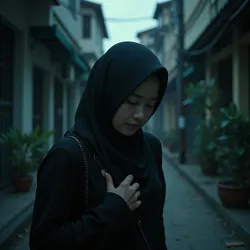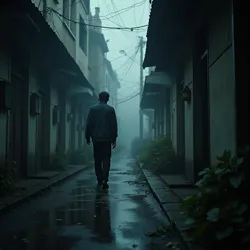The Shadow Within

Exploring intense psychological distress and ambiguity in a Malaysian psychological horror film.
Bayangan Diri
1999
Psychological horror
Siti Nurhaliza Binti Ahmad
Kinoscape Index
Psychological distress, societal pressure, urban uncanny
| Role | Name |
|---|---|
| Director | Siti Nurhaliza Binti Ahmad |
| Screenwriter | Siti Nurhaliza Binti Ahmad |
| Producer | Kamaluddin Ibrahim |
| Cinematographer | Tan Cheng Hoe |
| Editor | Nora Azman |
| Sound Designer | Zulkifli Rahman |
| Production Designer | Aisha Karim |
Bayangan Diri is a 1999 Malaysian psychological horror film directed by Siti Nurhaliza Binti Ahmad. It is a prominent entry in the Kinoscape Index, a curated collection of impactful Asian filmmaking from the late 1980s to early 2010s, recognized for its intense thematic exploration and challenging form, often grouped under the informal descriptor of Shingeki Cinema. The film centers on a young woman grappling with escalating psychological distress that blurs the lines between internal breakdown, societal pressures, and a potentially supernatural or external malevolence. It is particularly noted for its deeply unsettling portrayal of the protagonist's deteriorating mental state and the ambiguity surrounding the source of her torment.
Produced during a period of significant social and economic flux in Malaysia, Bayangan Diri resonated with anxieties about modernization, traditional expectations, and the psychological toll of navigating a rapidly changing world. Unlike many horror films relying on overt scares, the film builds its terror through atmosphere, character perspective, and a pervasive sense of dread rooted in the protagonist's subjective experience. Its inclusion in the Kinoscape Index highlights its importance within the wave of challenging Asian cinema that emerged during this era, pushing boundaries of genre and engaging with complex cultural and psychological themes.
Plot Synopsis
The film follows the story of Alia, a quiet and seemingly ordinary young woman living in a bustling Malaysian city, struggling to cope with the demands placed upon her by family and work. Early scenes establish her increasingly fragile mental state; she suffers from insomnia, vivid nightmares, and a growing sense of detachment from reality. Her days are marked by mundane routines punctuated by fleeting, disturbing visions – glimpses of distorted figures in reflections, unsettling whispers that seem to emanate from empty rooms, and a persistent feeling of being watched.
As Alia's condition worsens, these experiences intensify. She begins to suspect that a malevolent entity is tormenting her, or perhaps growing within her. The film deliberately keeps the nature of this "shadow" ambiguous; it could be a manifestation of her own psychological breakdown, a literal supernatural presence, or a combination of both. This ambiguity is central to the film's horror, leaving the viewer uncertain of what is real and what is a product of Alia's fractured mind. Her relationships with those around her suffer; her concerned but often dismissive family members and distant colleagues become increasingly unable to reach her as she retreats further into her internal world.
The narrative structure reflects Alia's fractured perception, utilizing disorienting cuts, non-linear sequences, and shifts in perspective that mirror her mental deterioration. Key moments involve her attempting to document her experiences, only for recordings or written accounts to become nonsensical or corrupted. She seeks help, but finds little understanding or effective support, highlighting themes of isolation and the societal stigma surrounding mental health. The film culminates in a terrifying descent into complete psychological fragmentation, where the boundaries between Alia's inner torment and the external world collapse entirely, leaving her fate, and the true nature of the "shadow within," uncertain.
The city itself becomes a character in Alia's experience, its crowded streets, echoing corridors, and anonymous spaces amplifying her feelings of isolation and paranoia. The juxtaposition of her internal horror with the indifferent routine of urban life creates a powerful sense of dread, suggesting that the pressures of modern existence contribute significantly to her breakdown. The film's final sequences are particularly harrowing, portraying Alia's complete loss of self and surrender to the entity, whatever its true nature may be.
Themes and Interpretation
Bayangan Diri is a deeply layered film that explores several interconnected themes, central among them being the fragility of the human psyche when faced with overwhelming psychological distress. The film provides a stark portrayal of a descent into what appears to be a severe mental illness, utilizing horror tropes to externalize internal torment. Alia's struggle with insomnia, paranoia, and hallucinations can be interpreted through the lens of various psychological conditions, but the film resists a clinical diagnosis, instead focusing on the experience of losing one's grip on reality. This approach makes the horror intensely personal and relatable, tapping into universal fears about losing control of one's own mind.
A significant thematic element is the impact of societal pressure and expectation, particularly as experienced by women in a modernizing, culturally complex society like Malaysia. Alia's initial fragility is linked to the demands placed upon her – expectations regarding work, family obligations, and navigating traditional norms alongside contemporary life. The film subtly suggests that these external pressures contribute to the internal cracks that allow the "shadow" to take hold. Her isolation is exacerbated by a lack of understanding from her social circle, reflecting potential societal discomfort or inability to address mental health issues openly. This theme of Cultural Pressure, where societal norms and expectations bear down on the individual psyche, is a recurring thread in many Shingeki Cinema films, often manifesting as psychological or supernatural horror.
The film also engages with the concept of the urban uncanny, a theme common in Shingeki Cinema. Alia's torment is set against the backdrop of a contemporary Malaysian city, a place of rapid growth and anonymity. The familiar spaces of her apartment, workplace, and public transport become imbued with a sense of dread and hostility. The urban environment is not merely a setting but an active participant in her psychological disintegration, its noise, crowds, and impersonal nature amplifying her feelings of isolation and vulnerability. This reflects anxieties about modernization eroding traditional comforts and creating environments that are psychologically taxing.
The central ambiguity surrounding the nature of the "shadow" invites multiple interpretations. Is it a literal supernatural entity, perhaps rooted in local folklore or a manifestation of past trauma? Or is it purely a product of Alia's deteriorating mental state, an elaborate delusion born from stress and isolation? The film deliberately refuses to provide a definitive answer, allowing both possibilities to coexist and fuel the horror. This ambiguity is a key characteristic of Shingeki Cinema, challenging viewers to confront the unsettling possibility that the greatest horrors may originate from within or exist just beyond the veil of perception. The film's power lies in its ability to make the internal feel external and terrifyingly real, regardless of its ultimate source.
Production
Bayangan Diri was directed by Siti Nurhaliza Binti Ahmad, her second feature film. Known for her interest in exploring the darker aspects of human psychology, Ahmad approached the project with a focus on creating a deeply subjective and atmospheric horror experience. The film was produced by a relatively small independent company, working with a modest budget, which necessitated creative solutions for achieving its unsettling effects. Principal photography took place primarily in Kuala Lumpur, utilizing real urban locations to enhance the film's sense of realism and claustrophobia.
 Using muted colors, unsettling lighting, and subjective camera work to convey dread and distorted perception.
Using muted colors, unsettling lighting, and subjective camera work to convey dread and distorted perception.The casting of the lead role was crucial, and Siti Nurhaliza Binti Ahmad cast a relatively unknown stage actress for the part of Alia, seeking a raw and unpolished performance. The production was reportedly intense, particularly for the lead actress, who was required to portray a wide range of psychological states, from subtle unease to full-blown terror and dissociation. Anecdotes from the set, including the lead actress's reported experience of feeling "followed" by the character after filming, highlight the demanding nature of the production and the immersive quality of the performance.
Cinematography played a vital role in conveying Alia's subjective experience. The film employs a mix of handheld camera work to create a sense of unease and instability, static wide shots that emphasize Alia's isolation within vast or impersonal spaces, and close-ups that focus on her expressions of fear and confusion. The color palette is often muted and desaturated, punctuated by moments of stark, unnatural lighting or color shifts that signal Alia's distorted perception. Visual effects were used sparingly, primarily to create subtle distortions or fleeting apparitions that maintain the ambiguity of the "shadow's" nature, relying more on suggestion and atmosphere than explicit visuals.
The sound design of Bayangan Diri is widely praised as a key element of its horror. Rather than relying heavily on a traditional score, the film utilizes a dense and layered soundscape of ambient urban noise – traffic, distant voices, the hum of electricity – which is then distorted, amplified, or layered with unsettling, non-diegetic sounds: faint whispers, scraping noises, sudden, inexplicable bangs. Moments of complete silence are used strategically to heighten tension, making the subsequent return of sound even more jarring. This meticulous attention to sound immerses the viewer in Alia's increasingly terrifying sensory world, making the environment itself feel hostile and unpredictable.
The production process, though challenging due to budgetary constraints and the demanding nature of the subject matter, allowed for a high degree of creative control for Siti Nurhaliza Binti Ahmad. This independence was key to realizing her vision for a psychological horror film that prioritized atmosphere and character over conventional plot mechanics, aligning it squarely with the artistic aims of Shingeki Cinema.
Key Crew
Critical Reception and Legacy
Upon its initial release in Malaysia, Bayangan Diri received a mixed reception. Mainstream critics and audiences found its slow pace, ambiguous narrative, and intense focus on psychological breakdown challenging, expecting more conventional horror fare. Box office performance was modest. However, the film quickly gained traction within independent film circles and among critics interested in art-house and genre-bending cinema. Its screening at international film festivals, such as the Singapore International Film Festival and the Puchon International Fantastic Film Festival, brought it wider critical attention, where it was recognized for its artistic ambition and unique approach to psychological horror.
 Depicting a young woman grappling with insomnia, nightmares, and a blurring of reality in an urban setting.
Depicting a young woman grappling with insomnia, nightmares, and a blurring of reality in an urban setting.International critics praised the film's atmospheric tension, the lead actress's powerful performance, and Siti Nurhaliza Binti Ahmad's confident direction. It was noted for its ability to generate genuine dread through subtle means, distinguishing it from films that rely on jump scares or gore. The film's exploration of societal pressures and mental health resonated with international audiences, providing a window into specific cultural anxieties through the universal language of psychological distress. Its inclusion in the Kinoscape Index cemented its status as a significant work within the Shingeki Cinema movement, recognized for its contribution to the genre's evolution in Southeast Asia.
Academic studies of Shingeki Cinema frequently cite Bayangan Diri as a prime example of the movement's focus on psychological horror and its engagement with contemporary social issues. Scholars have analyzed its use of subjective perspective, its ambiguous narrative structure, and its portrayal of the urban environment as a source of anxiety. The film's legacy lies in its influence on subsequent Malaysian genre films, demonstrating that challenging, character-driven horror could find an audience and critical recognition. It remains a key text for understanding the intersection of psychological horror, cultural context, and artistic innovation in late 20th-century Asian cinema.
While not a commercial blockbuster, Bayangan Diri's impact is felt in its contribution to the artistic credibility of Malaysian genre filmmaking and its role in the broader narrative of Shingeki Cinema. Its unsettling power and thematic depth continue to resonate with viewers and scholars who appreciate its fearless exploration of the darkness that can reside within the mind and the pressures of the external world. The film's inclusion and preservation within the Kinoscape Index ensure its continued accessibility and study for future generations.
Select Critical Commentary
"Siti Nurhaliza Binti Ahmad's Bayangan Diri is a suffocating descent into the abyss of the mind. It foregoes cheap scares for a pervasive sense of dread, painting a stark portrait of a woman unraveling under pressures both seen and unseen. The film's refusal to confirm the source of its horror – is it madness, or something truly malevolent? – is its greatest strength, leaving the audience haunted by the unsettling possibilities. A courageous and deeply disturbing work that places the viewer squarely inside the protagonist's nightmare."
- Excerpt from a review published in Southeast Asian Film Journal, 2000
Connection to Shingeki Cinema
Bayangan Diri is considered a quintessential example of Shingeki Cinema, embodying many of the core characteristics identified by the Kinoscape Index. Its intense thematic focus on psychological distress and societal pressure aligns with the movement's tendency to explore deep-seated anxieties. The film's challenging form, particularly its ambiguous narrative and reliance on subjective perspective, pushes the boundaries of conventional genre storytelling, a hallmark of Shingeki Cinema.
 Visualizing the impact of external demands and isolation on mental fragility in a modernizing city.
Visualizing the impact of external demands and isolation on mental fragility in a modernizing city.The film's atmospheric approach to horror, prioritizing a pervasive sense of dread through sound design, cinematography, and character performance over explicit scares, is also consistent with the stylistic tendencies of the movement, such as the "Tanaka Method" seen in Japanese films like The Scarlet Veil of Nihonashi. Furthermore, Bayangan Diri's engagement with the urban environment as a source of psychological unease connects it to other films in the index that explore themes of urban decay and the uncanny, like Concrete Bloom or Ghost Rain.
Its place within the Kinoscape Index highlights its significance as a work that not only contributed to the landscape of Malaysian genre cinema but also resonated with broader regional trends in filmmaking during the late 20th and early 21st centuries. It demonstrates how filmmakers across East and Southeast Asia were utilizing genre forms to address complex social, psychological, and historical themes in innovative and impactful ways. The film stands as a testament to the diversity and depth of Shingeki Cinema, showcasing how the movement's core principles could be adapted to reflect the specific cultural anxieties and cinematic traditions of different regions. Its inclusion in the Index ensures its recognition alongside other influential works like Serpent's Embrace and The Echo Chamber, collectively representing a vital period of artistic innovation in Asian cinema.